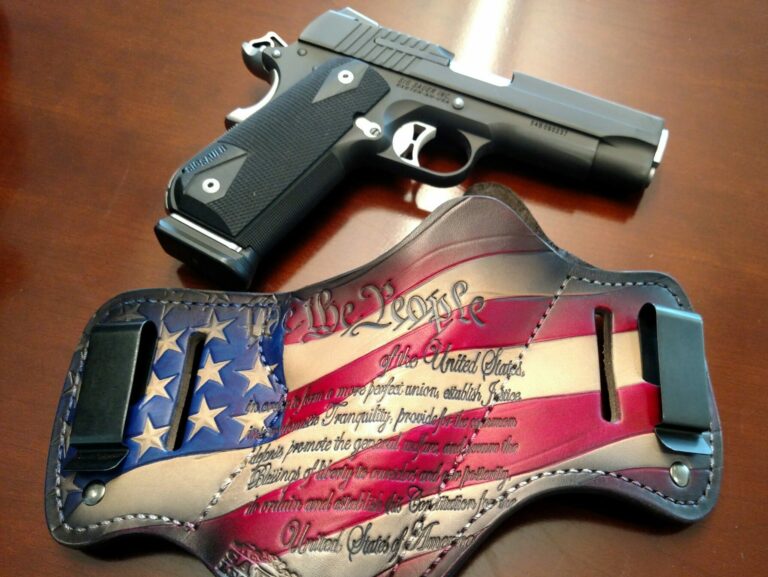A New York federal judge just ruled that the state’s ban on gun possession in churches is likely constitutional. How he got to that decision may be more interesting than the decision itself.
On Wednesday, U.S. District Judge Vernon Broderick denied a request for a preliminary injunction against a provision of New York law deeming all places of worship a “sensitive location” where gun carry is banned. He found that such a ban was consistent with the nation’s historical tradition of gun regulation.
“There is a sufficient historical record to support the finding that houses of worship are sensitive places, where it is constitutionally permissible for the state to regulate the carrying of firearms,” Broderick wrote in Goldstein v. Hochul. “There are both laws that specifically outlaw the carrying of weapons in churches or places of worship, and broader founding era regulations that limit the ability for law-abiding individuals to carry weapons in public generally, which would include inside places of worship.”
That “historical record” of “founding era” regulations Broderick identified relied heavily upon a series of laws, passed primarily in southern states and western territories between 1870-1889, that banned gun carrying into churches and other places of worship. That analysis, with its emphasis on late 19th-century historical analogues, marks a serious departure from how other judges have handled challenges to New York’s law to date.
By contrast, Judge John Sinatra of the Western District of New York—who issued an injunction against the exact same provision upheld by Broderick—explicitly rejected these same historical analogues as “insufficient in the search for an American tradition” of gun carry regulations, precisely because they were from the late 19th century.
“As a result the Court is left…with a handful of seemingly spasmodic enactments involving a small minority of jurisdictions governing a small minority of population,” Judge Sinatra wrote in his injunction order. “And they were passed nearly a century after the Second Amendment’s ratification in 1791. These outlier enactments also contrast with colonial-era enactments that, in fact, mandated such carry at places of worship.”
Here, Sinatra seems to suggest that 1791 is the controlling time period for understanding the Second Amendment and the historical tradition of gun regulations, as he explicitly favors pro-gun-carry laws enacted around the time of the founding over later Reconstruction-era laws prohibiting the same conduct. These competing visions over the relevant history center around which date appropriately demarcates how the Second Amendment is to be properly understood, with starkly different outcomes depending on the time period chosen.
Supporters of a 1791-focused analysis argue that Second Amendment’s meaning is fixed to when the original founders ratified it in the Bill of Rights. Therefore, in this view, any historical tradition of firearms regulation must begin during or before this era to be considered valid.
On the other hand, supporters of an 1868-focused analysis argue that the Fourteenth Amendment’s ratification is what matters. That’s because the Reconstruction-era amendment made all preceding amendments in the Bill of Rights applicable to the states for the first time, according to the Supreme Court’s incorporation doctrine. Therefore, they would argue, the understanding of the Second Amendment and its limits that were in place in state and local governments during this time would be pertinent in determining the proper historical tradition of gun regulation.
The Supreme Court, for its part, appears to have tipped its hand toward a preference for a tradition beginning around the original founding, in 1791. Justice Thomas wrote for the majority in Bruen that the Second Amendment’s “meaning is fixed according to the understandings of those who ratified it.”
“We have made clear that individual rights enumerated in the Bill of Rights and made applicable against the States through the Fourteenth Amendment have the same scope as against the Federal Government,” Thomas wrote. “And we have generally assumed that the scope of the protection applicable to the Federal Government and States is pegged to the public understanding of the right when the Bill of Rights was adopted in 1791.”
However, he did point to a degree of ambiguity regarding whether the historical tradition surrounding the Constitution’s ratification in 1791 or the era of the ratification of the Fourteenth Amendment—which incorporated the Bill of Rights to the states—in 1868.
“We also acknowledge that there is an ongoing scholarly debate on whether courts should primarily rely on the prevailing understanding of an individual right when the Fourteenth Amendment was ratified in 1868 when defining its scope,” Justice Thomas wrote.
Ultimately, Thomas chose not to resolve that ambiguity in the Bruen decision because, as he stated, “the public understanding of the right to keep and bear arms in both 1791 and 1868 was, for all relevant purposes, the same with respect to public carry.”
As such, the lower courts currently confronted with public challenges to gun laws under the Bruen test have been left to their own devices in figuring out which time period represents the proper scope of inquiry for determining what constitutes a historical tradition of gun regulation. That’s led to radically different results, even beyond the New York case.
For instance, a three-judge panel for the Eleventh Circuit Court of Appeals upheld Florida’s ban on gun sales to those under the age of 21 by heavily relying on Reconstruction-era laws in its analysis of the historical tradition of gun regulations.
“[I]t’s clear that the public understanding of the Second Amendment at the time of the Fourteenth Amendment’s ratification—as demonstrated by the wealth of Fourteenth Amendment Ratification Era analogues for Florida’s law—permitted the states to limit the sale of firearms to those 21 and older,” Judge Robin Rosenbaum wrote in that ruling. “So even if federal law obliged 18-to-20-year-olds to muster for the militia, laws banning that same group from buying firearms do not infringe on the right to keep and bear arms.”
On the other hand, a Minnesota federal judge struck down a law prohibiting that same age group’s ability to obtain gun-carry permits.
“Based on a careful review of the record, the Court finds that Defendants have failed to identify analogous regulations that show a historical tradition in America of depriving 18–20-year-olds the right to publicly carry a handgun for self-defense,” Menendez wrote in her Worth v. Harrington opinion. “As a result, the age requirement prohibiting persons between the ages of 18 and 20 from obtaining such a permit to carry violates the Second Amendment.”
Menendez even directly called out the Eleventh Circuit for its reliance on history after 1868 to constitute a valid historical tradition of gun regulation.
“In this Court’s view, Bondi declined to follow rather clear signs that the Supreme Court favors 1791 as the date for determining the historical snapshot of ‘the people’ whose understanding of the Second Amendment matters,” Menendez wrote.
Until the Supreme Court steps in and definitively resolves the “ongoing scholarly debate” over which time period is best for understanding the scope of the Second Amendment and its protections, expect to see lower courts continue to radically diverge over what modern gun-control laws are permissible.






